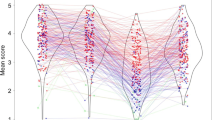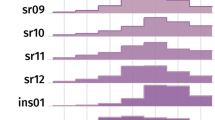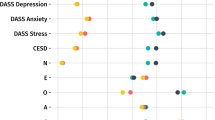Abstract
Results reported in the literature from thinking research are difficult to compare because the various studies differ on three independent dimensions: whether the observations are immediate or retrospective, whether the observations are targeted at measuring single moments in time or multiple moments, and whether the observations are directed at specific thought events or at characterizing thought events in general. Furthermore, questionnaire and sampling studies typically collect data on differing sets of variables. In an attempt to separate the influences of these dimensions in the thoughtsampling literature, factor-analytic techniques were applied to five studies in which subjects described their thoughts and moods on the same 42-variable rating questionnaire. Studies were designed to differentiate between factors produced using immediate versus retrospective techniques, single-moment versus multiple-moment techniques, and specific-event versus indeterminate-event techniques. Factors that had occurred in previous research called Aggressive/Bad Mood, Pleasant/Sexual, Clear Thought, Daydream/Past Sexual, Duration, and Self-Critical were found in all five studies. However, factor-loading patterns in the five studies were somewhat different, leading to the conclusions that the retrospective nature of questionnaires is likely to distort the frequency of recollections in thinking; that the indeterminate nature of retrospective questionnaires might lead to the erroneous conclusions that clarity in thinking is associated with pleasant thoughts and to a minimization in the reports of strength of negative affect; and that either the multiple-moment nature or the between-people analysis of retrospective questionnaires might lead to exaggeration of the relationship between sex and aggression in experience.
Similar content being viewed by others
References
Antrobus, J. S., Singer, J. L., & Greenberg, S. (1966). Studies in the stream of consciousness: Experimental enhancement and suppression of spontaneous cognitive processes.Perceptual and Motor Skills, 23 399–417.
Cameron, P., & Giuntoli, D. (1972). Consciousness sampling in the college classroom or Is anybody listening?Intellect. October, 63–64.
Cattell, R. B. (1957). Personality and motivation structure and measurement. New York: World Book.
Csikszentmihalyi, M., Larson, R., & Prescott, S. (1977). The ecology of adolescent activity and experience.Journal of Youth and Adolescence, 6 281–294.
Cundiff, G., & Gold, S. R. (1979). Daydreaming: A measurable concept.Perceptual and Motor Skills, 49 347–353.
Giambra, L. M. (1974). Daydreaming across the lifespan: Late adolescence to senior citizen.Aging and Human Development, 5 116–135.
Giambra, L. M. (1977). Daydreaming about the past—The time setting of spontaneous thought intrusions.Gerontologist, 17 35–38.
Giambra, L. M. (1981). Daydreaming, attentional processes, and curiosity in white Americans: Religious, educational, economic and residency influences for a life span sample.Journal of Clinical Psychology, 37 262–275.
Giambra, L. M. (1983). Daydreaming in 40- to 60-year old women: Menopause, health, values, and sexuality.Journal of Clinical Psychology, 39 11–21.
Giambra, L. M., & Traynor, T. D. (1978). Depression and daydreaming: An analysis based on self-ratings.Journal of Clinical Psychology, 34 14–25.
Gilchrist, M. B. (1982). Creative talent and academic competence.Genetic Psychology Monographs, 106 261–318.
Gold, S. R., & Cundiff, G. (1980). Increasing the frequency of daydreaming.Journal of Clinical Psychology, 36 116–121.
Huba, G. J., Segal, B., & Singer, J. L. (1977). Consistency of daydreaming styles across samples of college male and female drug and alcohol users.Journal of Abnormal Psychology, 86 99–102.
Humphrey, G. (1951).Thinking. London: Methuen.
Hurlburt, R. T. (1976). Self-observation and self-control. Unpublished doctoral dissertation, University of South Dakota.
Hurlburt, R. T. (1979). Random sampling of cognition and behavior.Journal of Research in Personality, 13 103–111.
Hurlburt, R. T. (1980). Validation and correlation of thought sampling with retrospective measures.Cognitive Therapy and Research, 4 235–238.
Hurlburt, R. T., Lech, B. C., & Saltman, S. (1984). Random sampling of thought and mood.Cognitive Therapy and Research, 8 263–275.
Hurlburt, R. T., & Melancon, S. M. (1987a). P-technique factor analyses of individuals' thought and mood-sampling data.Cognitive Therapy and Research, 11 487–500.
Hurlburt, R. T., & Melancon, S. M. (1987b). Correlates of thought-sampling data in a classroom setting. In press.Journal of Research in Personality.
Joffe, C. H. (Producer). (1977).Annie Hall. New York: United Artists. (Film).
Klinger, E. (1978–1979). Dimensions of thought and imagery in normal waking states.Journal of Altered States of Consciousness, 4 97–103.
Klinger, E., Barta, S. G., & Maxeiner, M. E. (1980). Motivational correlates of thought content frequency and commitment.Journal of Personality and Social Psychology, 39 1222–1237.
Klinger, E., & Cox, W. M. (1985).Dimensions of thought flow in everyday life. Paper presented at the American Psychological Association Annual Meeting, Los Angeles.
Pope, K. H., & Singer, J. L. (Eds.). (1978).The stream of consciousness: Scientific investigations into the flow of human experience. New York: Plenum.
Segal, B., & Singer, J. L. (1976). Daydreaming, drug, and alcohol use in college students: A factor analytic study.Additive Behaviors, 1 227–235.
Singer, J. L. (1974). Daydreaming and the stream of thought.American Scientist, 2 417–425.
Singer, J. L. (1975a).The inner world of daydreaming. Harper & Row.
Singer, J. L. (1975b). Navigating the stream of consciousness: Research in daydreaming and related inner experience.American Psychologist, 30 727–738.
Singer, J. L., & Antrobus, J. S. (1970).Imaginal processes inventory. Princeton: Educational Testing Service.
Starker, S. (1978). Dreams and waking fantasy. In K. S. Pope & J. L. Singer (Eds.),The stream of consciousness: Scientific investigation into the flow of human experience (pp. 302–319). New York: Plenum.
Starker, S., & Singer, J. L. (1975). Daydreaming and symptom patterns of psychiatric patients: A factor analytic study.Journal of Abnormal Psychology, 84 567–570.
Author information
Authors and Affiliations
Rights and permissions
About this article
Cite this article
Hurlburt, R.T., Melancon, S.M. How are questionnaire data similar to, and different from, thought-sampling data? Five studies manipulating retrospectiveness, single-moment focus, and indeterminacy. Cogn Ther Res 11, 681–703 (1987). https://doi.org/10.1007/BF01176005
Issue Date:
DOI: https://doi.org/10.1007/BF01176005




